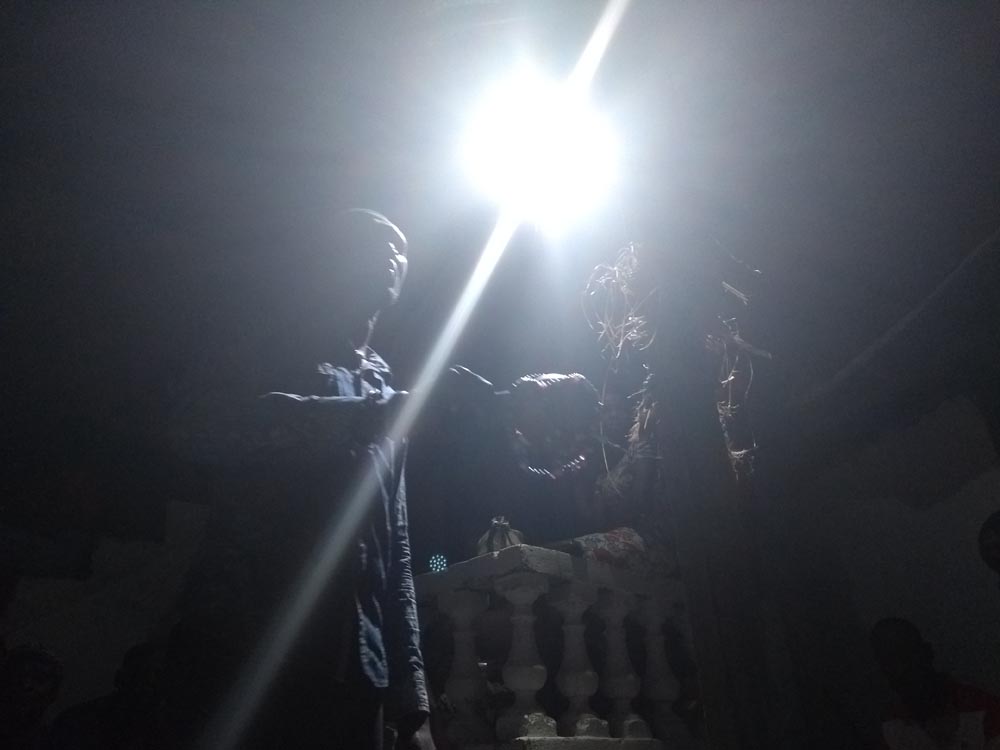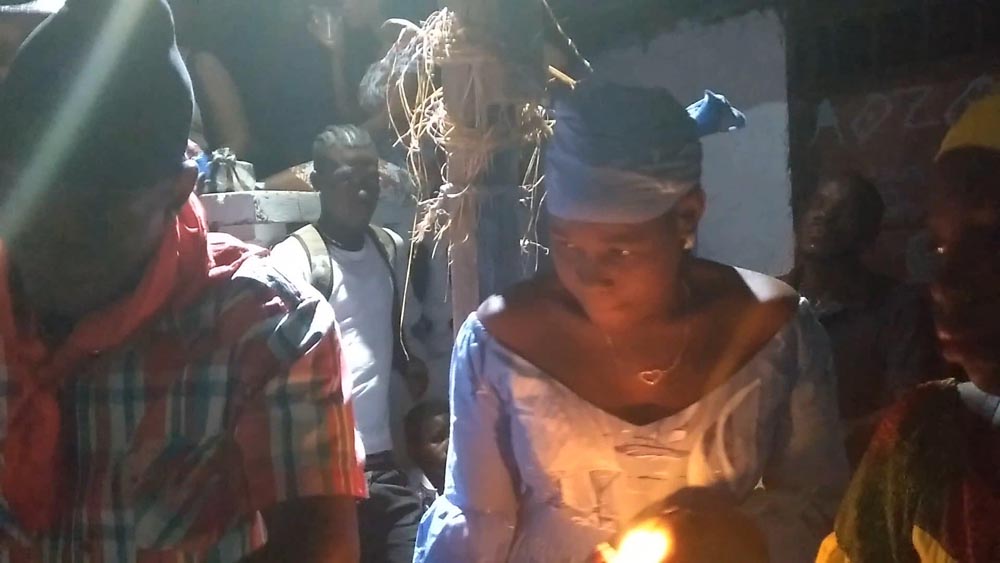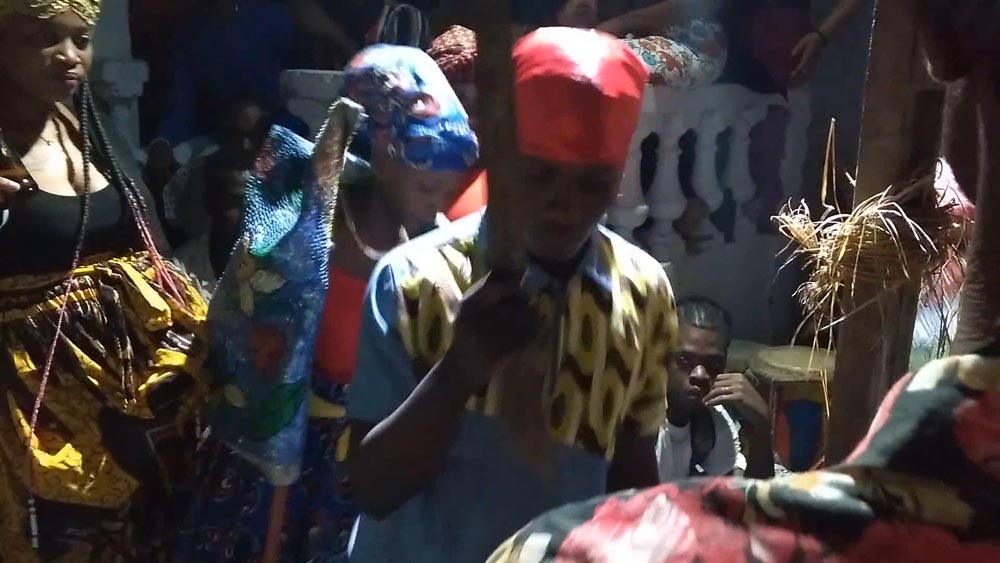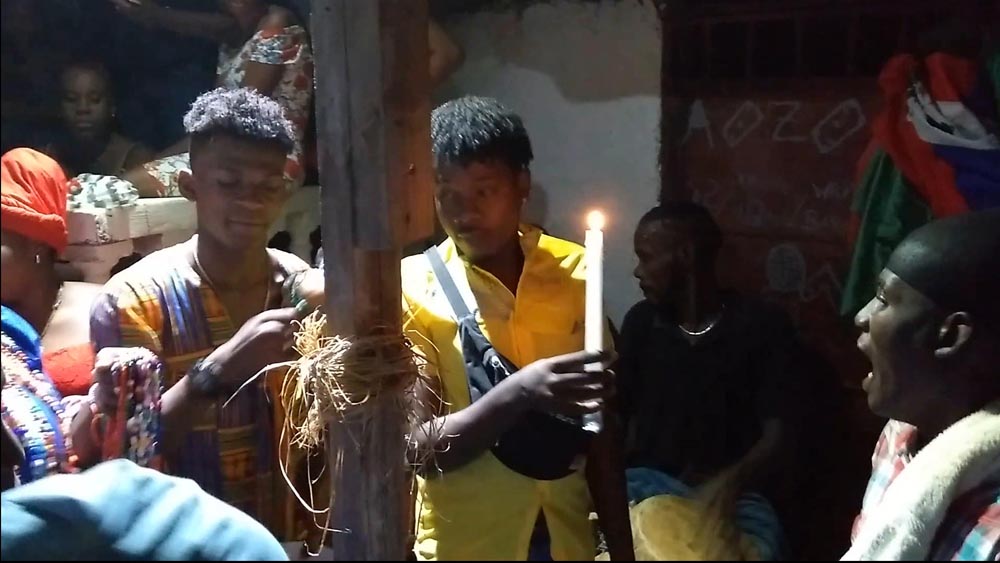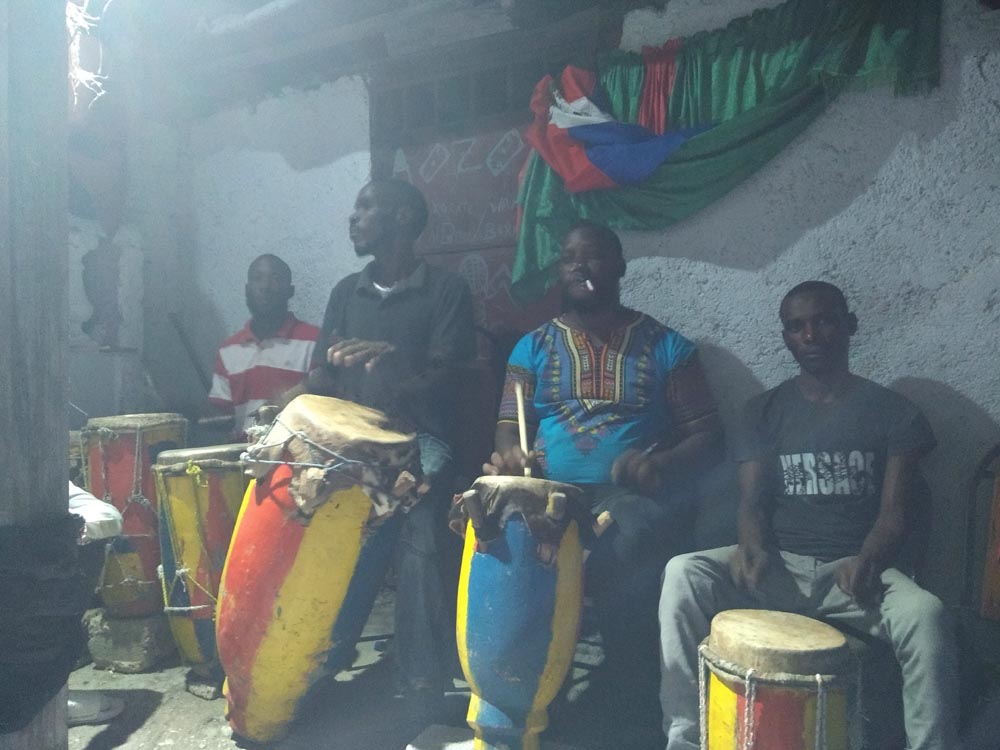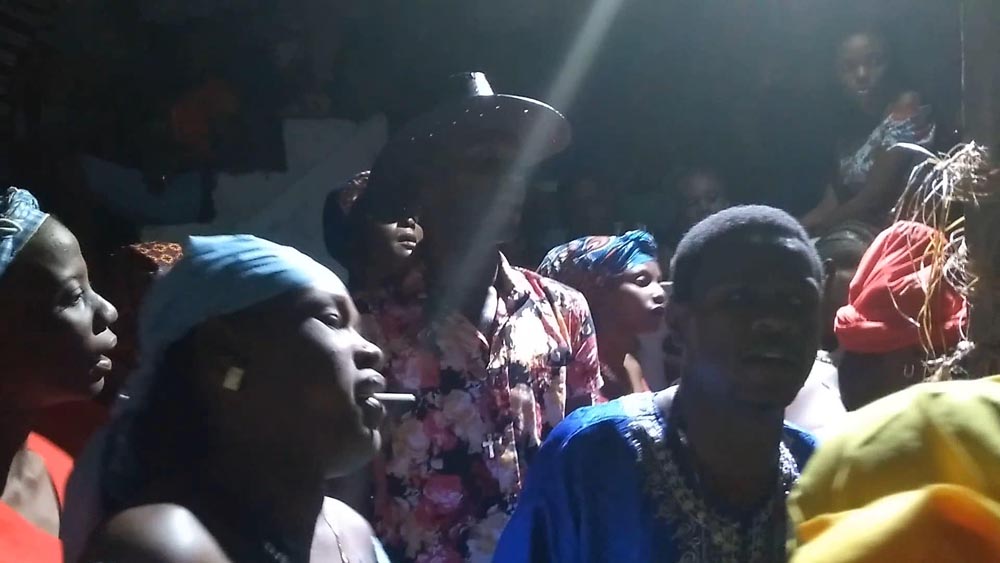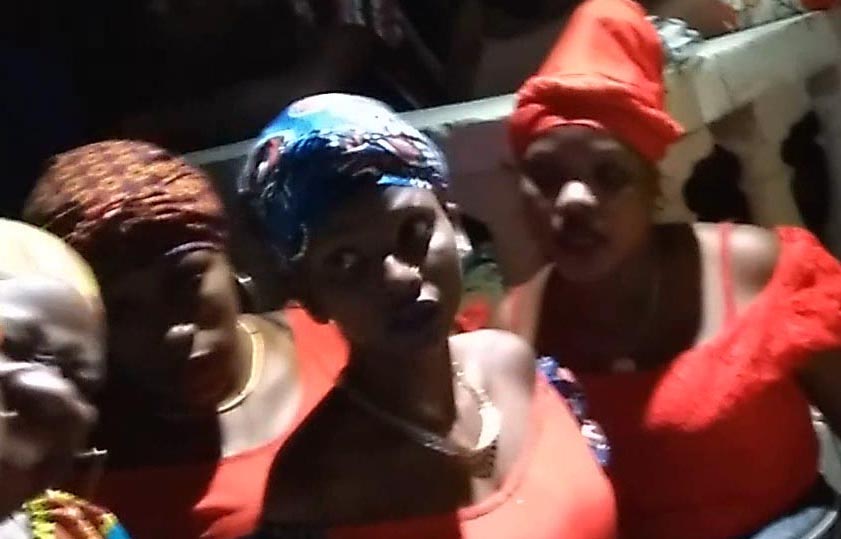This is part 3 of this series by Dean Karalekas you can read part 1 here and part 2 here.
The itinerary of the day so far was a whirlwind, taking in visits not only to the Marché de Fer, Atis Rezistans, the Notre-Dame Cathedral, and the monuments adorning Port-au-Prince’s main square, but also—and most memorably—a visit to a neighbourhood peristile. Moreover, the day had started earlier than most.
Due to the global lockdowns instituted as a response to COVID-19, the land border between the Dominican Republic and Haiti—like the land border between the United States and Canada that, in a roundabout way, precipitated this odyssey I was on—is closed tight. Flights are available, but they are far more expensive than the bus, and you are at the mercy of the airline’s timetable. In my case, the only available flight left Santo Domingo that morning at around 7 AM, and the airline was quite clear: be at the airport a full three hours prior to the scheduled takeoff. That meant getting up at 3 AM for a shower, a shave, and to meet Alejandro, the hotel driver, early enough to make the airport by 4 AM.
I had been staying at the El Beaterio, a converted 16th-century convent in Santo Domingo’s Zona Colonial, to wait out the necessary two weeks until I could enter the United States. The hotel is beautiful, and the service is excellent, though I was the only guest, as far as I could tell. The Dominican Republic was open to tourism, at least in theory; in practice, there was a nationwide curfew; the museums, beaches, and most of the shops and restaurants were closed; and only vehicles with authorization could be driving around after 7 PM. Fortunately, Alejandro had such authorization.
After an eerie drive to the airport through the deserted streets of Santo Domingo, Alejandro and I said our goodbyes and made arrangements to meet once more the following week, after my return flight. But of course, the airport wasn’t open at 3 AM: The doors were locked and the lights were off. I sat and smoked cigarettes for about an hour until another couple showed up, presumably for the same flight, and began banging on the door. The night watchman was polite but firm with them: we open when we open.
Eventually they did open, and after weighing me and my bag—when I told the clerk that I didn’t have any bags to check, he asked me to stand on the scale, holding my carryon bag—they printed me a boarding pass, and I sat down to wait for the security agents to down their morning coffee and warm up the X-ray machines. Eventually, the passengers were escorted across the tarmac to board a tiny Jetstream 32 turboprop. I see now why they had to weigh me: this thing looked like a toy. I half expected to see a kid nearby with a remote control.
Since then, the day hadn’t stopped, and so while I was now quite exhausted, I was glad to be back at the Oloffson Hotel and finally able to unpack and change, take a quick shower, and hopefully get an hour or so of sleep before the big event tonight.
Unfortunately, though, sleep wouldn’t come. The Oloffson, after dark, is a playground for ghosts, either real or imaginary. Adding to my growing sense of dread was the swarm of bees that appeared outside my door, buzzing around the porch light and ensuring I dare not step outside for a cigarette to calm my nerves. The Celts believed that bees were the link between the world of the living and that of the dead, and that they could carry messages between the two. I don’t know what message they had for me tonight, crawling all over the transom glass.
After a shower, I decided to put my clothes away. A large wooden dresser dominated the foyer. The top drawer was lined with wallpaper with a Victorian-era design. It was cobwebbed, and held only one item, someone’s necklace, left behind. I checked the next drawer down, and it too held a single item, what looked like a five-round magazine for a .308 rifle. I decided not to peek into any other drawers.
The ride over to the temple on the motorcycle at night was just as hard on my coccyx, but at least there wasn’t the sun to deal with. I had left home months ago without thinking to pack sunblock—I had no idea I’d end up in Haiti—and was already feeling the effects. I’d be red as a lobster tomorrow. I also hadn’t packed my camera, which meant the only photos or video would be courtesy of my cellphone camera. A shame, considering this unique cultural opportunity.
We arrived at the Sosyete Apredye early and found 40 or 50 Vodouyizans already there, waiting patiently for the festivities to begin. The ceremony would take place in an otherwise nondescript lane behind the main road—not at all what I was expecting. Of course, my imagination was fed by what little images of Vodou I had seen courtesy of movies and television, most notably over-the-top depictions in the 1973 James Bond film Live and Let Die, as well as the disappointing 1988 horror movie The Serpent and the Rainbow (note to readers: the book by Wade Davis is excellent: the film, not so much).
Azda and I claimed an unobtrusive spot in the back to wait as more congregants arrived, filling the tiny alley to overflowing. As the only white man in attendance, I stood out somewhat. One attendee, sitting high up on a stairwell, called out to me in a distinctive New York accent. He introduced himself as Pryce, from Brooklyn, and we chatted for a bit. It was comforting to hear his distinctive inflection in what was otherwise an environment completely alien to me. Of course, here, I mused, the alien was me. This was amplified by the garish Aloha shirt I was wearing—the only collared shirt I had packed. I was glad to be tucked in the back where I could observe the proceedings at a respectful distance, as unobtrusively as possible.
My low profile would not last, however. Just before the ritual began, Fourchard pulled me out of my hiding spot and placed me in a small chair located front-and-center. He kindly introduced me to the drummers, and to their drums—each drum in the Vodou ceremony is known by a distinctive name, and has a unique role to play, even as they complement each other. Maman, the mother of all drums judging by its size, leads the assembly, as Boula keeps the rhythm with its high, muted tone played with drumsticks. The middle drum, Segon, provides a counterpoint to Maman. As various congregants left to change into new attire, the drummers warmed up, and a young man whom I took to be an apprentice drummer was called over to tighten the goat or cow skin on Maman. Using a mallet, he hammered the wooden pegs deeper into the holes cut around the circumference of the mother drum.
Once the drummers started in earnest, they really made their drums talk. It was easy to see how one might lose oneself in the rhythms. Fourchard began by affixing something—a votive object perhaps?—to a wooden column that stood in the centre of this tiny space between buildings. I began to wonder if the pillar was somehow important. Dancers appeared, the women dressed in colourful Quadrille and headwraps; the men less formally, some in guayabera. Led by Fourchard, and later Bisint, the choir raised their voices in song as the drums set a hypnotic rhythm.
The drumming was insistent. This practice—as much spiritual as musical—was brought here by slaves from their native West Africa, and it predates the historical record, passed down from master to apprentice through the generations. Each drummer played a reasonably simple pattern, but overlaid they assembled a multifaceted wall of poly-rhythms. As they did, the spiritual energy of this space became manifest, and even I began to feel the cathartic energy of the drumming, the dancing, and the shimmering ason rattles in cycle after cycle of ritualization, as the houngans and the Vodouyizans performed songs in a call-and-response supplication to each of their Lwa. Tonight’s seremoni was in service to the Lwa of this particular Sosyete: Dantò, Tijan, Agarou, Freda, the queen of Congo, and gede, Kouzin. Each was honoured in turn, as the participants paid their respects to the drummers, the pillar, and the assembled congregation.
Each iteration of song, drum, and dance coalesced into the next as it collectively built up to move the seremoni forward to its intended conclusion: to summon the Lwa through the conduit consisting of the ritual and music, and to beckon them to enter our realm and take possession of the bodies of the faithful. After mounting her chosen chwal—literally, “horse”—the Lwa will offer congregants advice and protection (requests usually concern health-related matters, but also about love or business). At times, while in human form, the spirits issue warnings, or offer prophesies of future events. Sometimes, it is said, these come later, in dreams.
The quid pro quo for such boons comes not only in the form of songs performed for the Lwa, but in animal sacrifices. The sacrifices that are such an integral component of this ritual, and which must be performed to sanctify the event and pay appropriate homage, were all conducted earlier in the day, and now the congregants were laying candles at the base of the wooden post and sketching Vèvès—sigils distinctive of a particular Lwa—into powder on the temple ground.
Two women draped in the Drapo Vodou of this Sosyete appeared, as did a man armed with a machete, and together they began moving in time with the ever-present drums. They joined in the synchronized dancing and rattle work of the priests as others twirled and bowed in meeting, which to my mind was akin to the square dancing moves I learned as a boy. The flags, now wrapped tightly and brought together in a point supported by the machete, were used to single out persons in the assembly. Just as quickly, their graceful wielders disappeared, and another round of the ritual began anew.
This continued for hours: Round and round, salutation and supplication; honouring the Lwa, and saluting the stations of the peristyle, raising into a crescendo of tempo, twirling, and prayer, and then slowing down into almost a repose. Being stationed so near the centre of it all, I was jostled about by the Vodouyizans as they pressed on with summoning their gods. I was mere feet from the central pole. I stood, so my knees weren’t in their way, but now my entire body formed an obstruction. I willed myself to become smaller, but to no avail. Throughout it all, it soon became obvious even to my ignorant eye that the polewas more than just the physical centre of this sacred space: it was the beating heart of everything happening here tonight.
I would later learn that all Vodou temples have such a column at their spiritual and physical centre. Called a potomitan, it is the psychic hub around which the spokes of the universe rotate. Like so many belief systems that incorporate the concept of circle-casting, the pillar here represents the axis mundi—the cosmic axis, or world tree—known to the Vikings as Yggdrasil; to the Tibetan Buddhists, it is symbolised by the ritual Phurba dagger; and it is also the omphalos of the ancient Greeks. Maypoles; Minarets; totem poles: The language of symbolism transcends culture, for culture offers only surface differences, whereas the underlying idea is universal to all mankind: to create a ritually purified space so that access may be granted to spirits from other realms, and to create a doorway between our world and the next.
This door would be opening, here, tonight, just feet from where I was standing. The drums played their patterns over top of each other, winding and twisting through syncopated rhythms that turned back in on themselves, creating a dense, complicated and yet visceral percussion that reached deep into the soul of the Voudouisants as it called forth the Lwa to mount her vessel. This was a psychological and spiritual constant I was witnessing, stripped of the artifices and baggage of dogma and philosophy: the universal Shamanistic imperative—and indeed, the duty of each of us, in his own life—to breach the axis mundi and peer deeply into the realm of chaos, into The Other Side, to bring back knowledge for the betterment of our lives and our communities, risking madness to increase our understanding of the universe, and of ourselves.
I felt myself becoming lightheaded contemplating it all. It was an eternity of round after round of ritualization, and the persistence of the drums and rattles leading the increasingly frenzied dance. It didn’t help that I had been awake now for—what was it, almost 24 hours? I smoked a cigarette, but that only made my head spin more. Inadvertent collisions with the dancers became more frequent, and I was losing my footing. A woman, a dancer, in front of me started shaking in an arrhythmic way. Her partner moved in to support her as her head fell back and her eyelids began to flutter. The drummer playing Maman must have seen this too, because he quickly changed the rhythm, allowing the woman to take possession of herself. Too soon. It was not yet time.
But it was time for me. It could be hours yet before the Lwa mounts her chwal, and I was fading fast. I didn’t know then that foreigners can never be host to the Lwa—that knowledge would have been a comfort, because the ceremony was having an effect on me. I decided I had to leave.
I told myself it was the right call. This was obviously an intensely personal and private experience for members of this congregation, and here I was with my loud shirt and phone camera intruding on their religious observance. How would I feel if some foreign anthropologist went around snapping pictures at my Goddaughter’s baptism? Besides, I had seen spirit possession before, years ago in the jungle of Siberut, and it is serious business. It is not a tourist attraction. Politeness dictated that I intrude no further on these kind people’s religious observance, so I found Azda and took my leave.
I have no idea what happened after I left—whether the Lwa mounted her Chwal; what wisdom she conferred from the other side of the veil between worlds. I only knew that I had already experienced more than I had bargained for, and would have to pace myself. This was, after all, still day one.


